



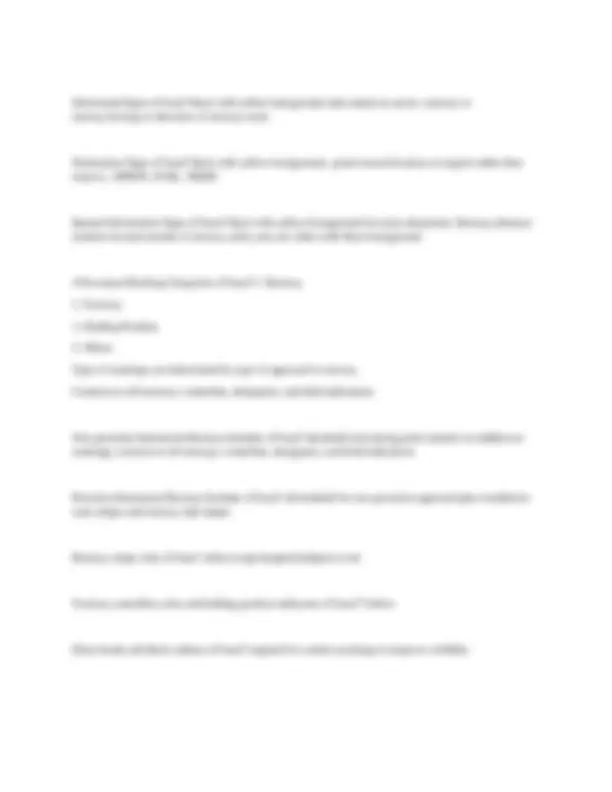



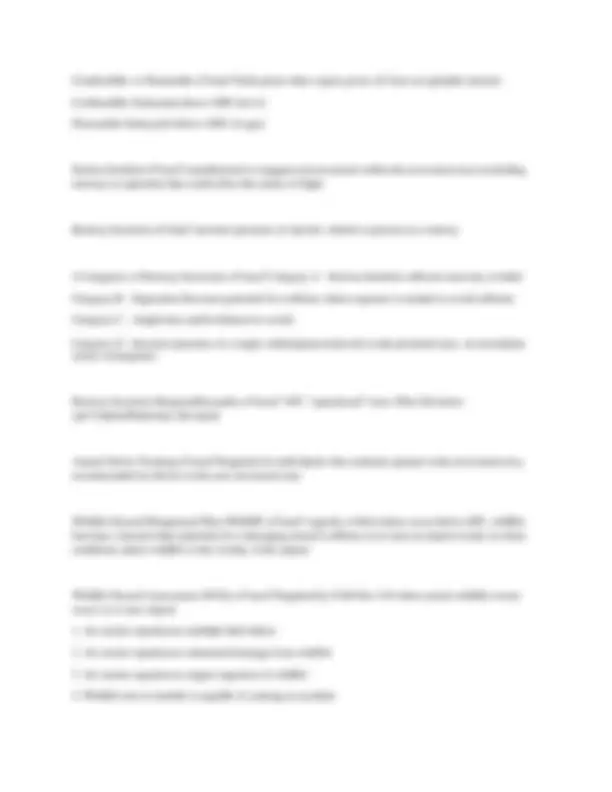
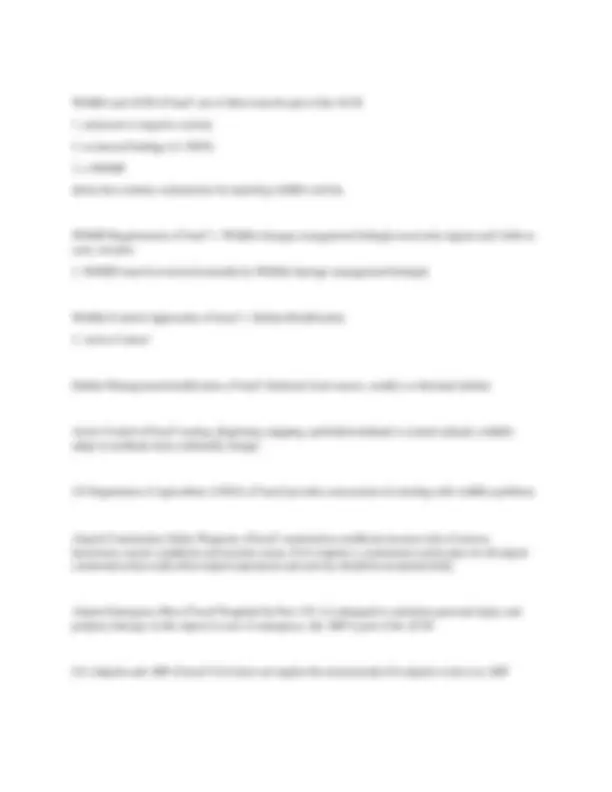

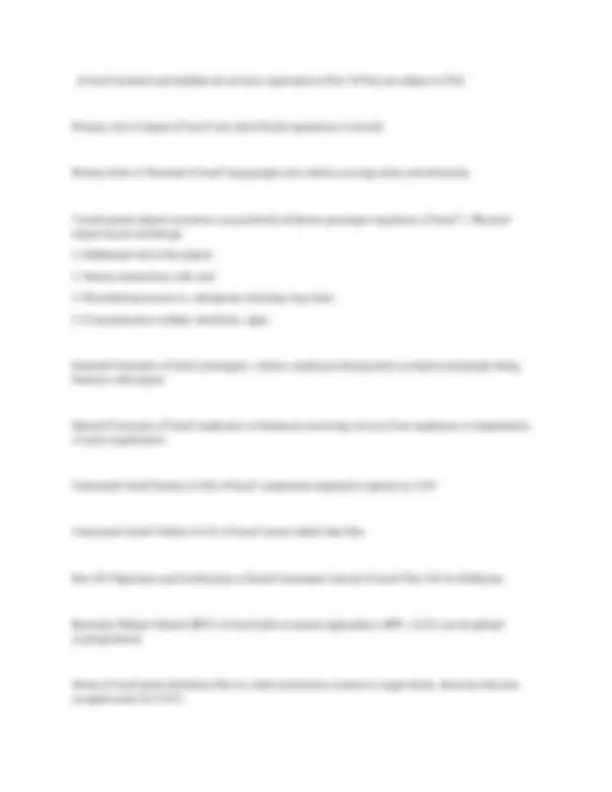
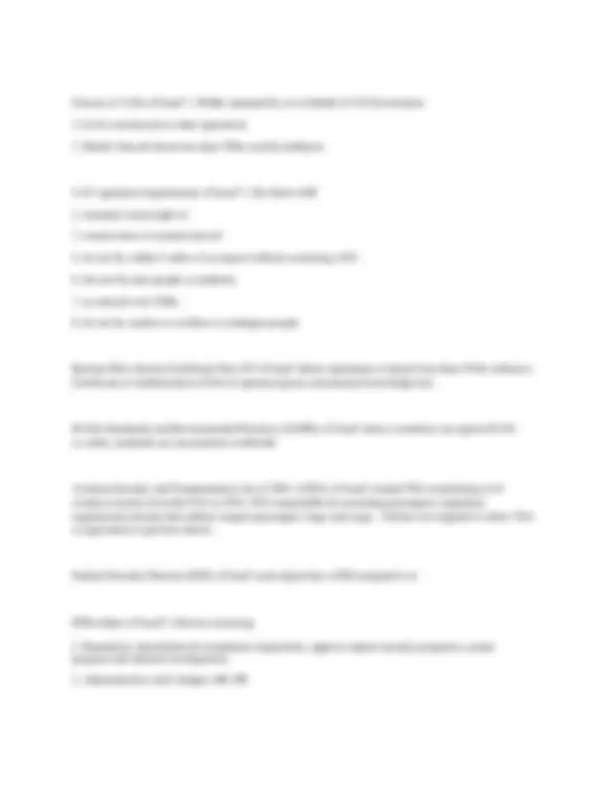
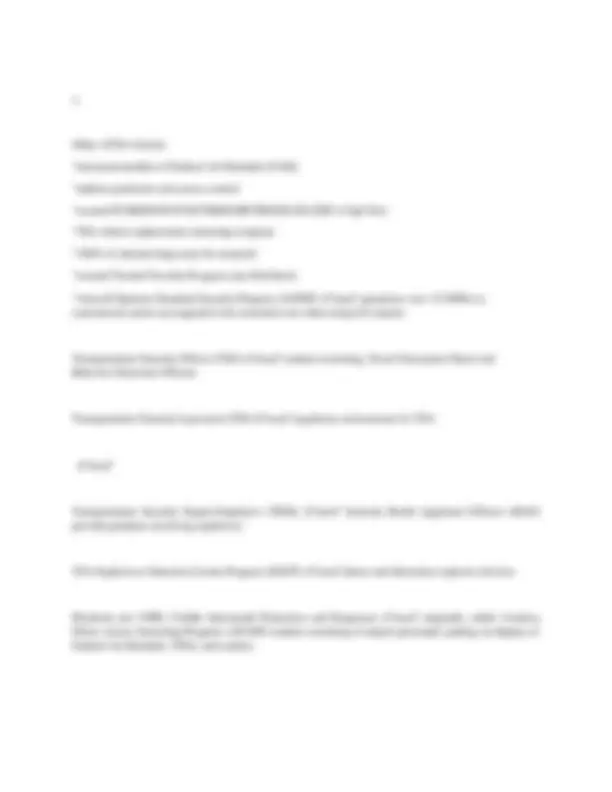

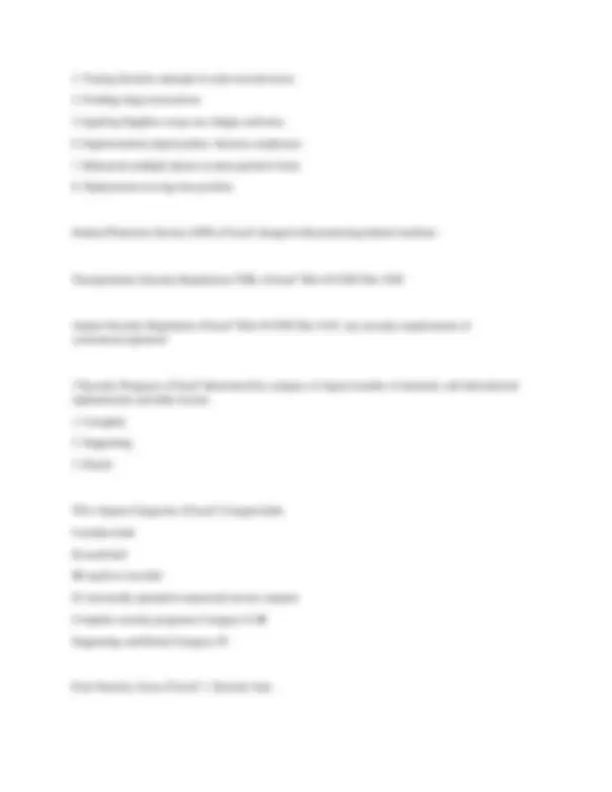

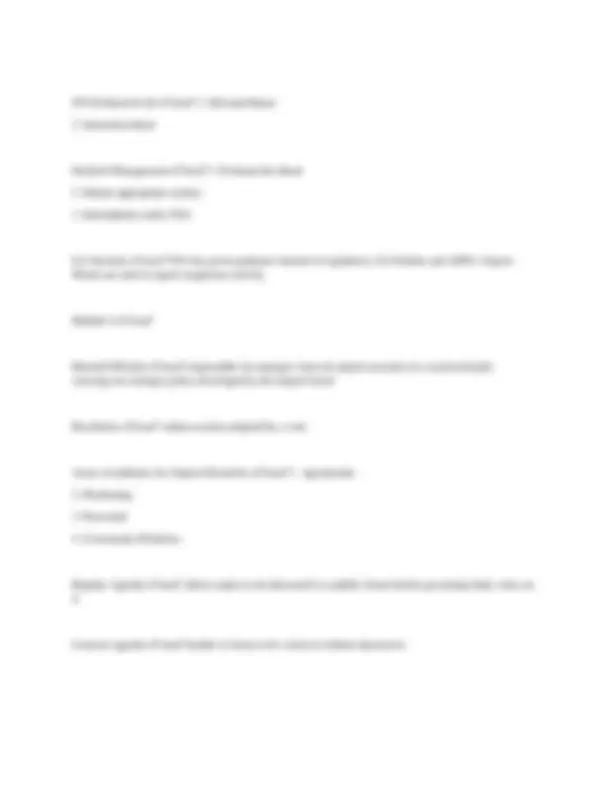
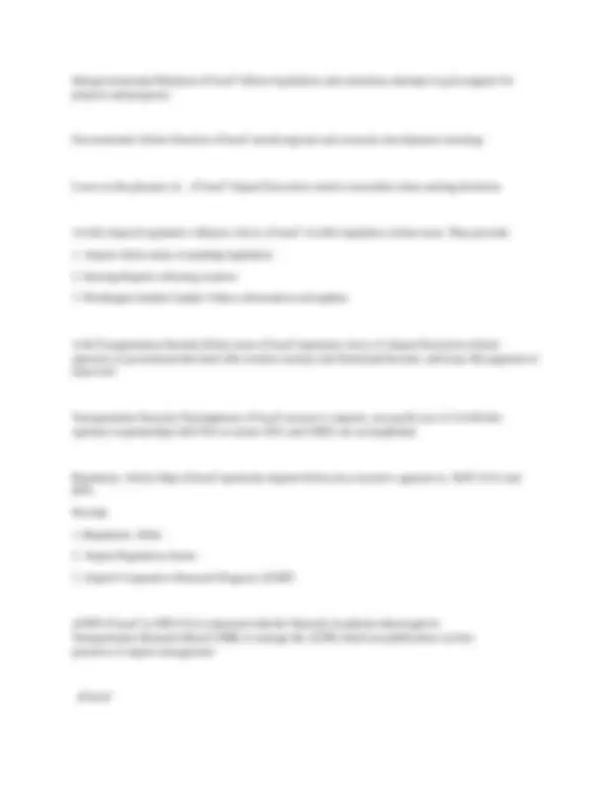


Study with the several resources on Docsity

Earn points by helping other students or get them with a premium plan


Prepare for your exams
Study with the several resources on Docsity

Earn points to download
Earn points by helping other students or get them with a premium plan
Community
Ask the community for help and clear up your study doubts
Discover the best universities in your country according to Docsity users
Free resources
Download our free guides on studying techniques, anxiety management strategies, and thesis advice from Docsity tutors
This document provides a comprehensive overview of the key safety and security regulations governing airports in the United States. It covers topics such as the safety management system, airport certification, aircraft classifications, approach lighting, emergency planning, passenger experience, and unmanned aerial systems. It also delves into aviation security measures, airport access control, and the roles and responsibilities of airport executives. This resource would be highly valuable for students studying airport operations, aviation management, or transportation security.
Typology: Exams
1 / 26

This page cannot be seen from the preview
Don't miss anything!



















Airport Certification Manual (ACM) ✔Ans✔ methods airport management can use to ensure airport safety and efficiency Safety Management System (SMS) 4 Elements ✔Ans✔ 1. Safety Policy
Airports reqired operating certificates ✔Ans✔ 1. Scheduled or unscheduled air carrier aircraft with more than 30 seats
Concrete ✔Ans✔ rigid. poured in slabs that require seams to allow for expansion, higher cost, can withstand higher aircraft loads, resists weathering and fuel or oil spills Preventative Maintenance ✔Ans✔ Pavement life is dependant on it, part of Pavement Management System, regular/recurring work to sustain it, engineered for 20 year structural life Part 139 Daily Insection Requirement ✔Ans✔ of airport pavement in the Movement Area. In addition, periodic maintenance inspections should be conducted at least twice per year. Inspection must occur before daily flights begin and again at night if airport has night air carrier operations Pavement Condition Index ✔Ans✔ industry standard for qualifying airfield pavements Pavement Management Programs (PMP) or Airport Pavement Management Systems (APMS) ✔Ans✔ create procedures for scheduled maintenance and rehabilitation, projects rate of deterioration therefore assist in planning maintenance at optimal time 2 Pavement Deterioration Causes ✔Ans✔ 1. Environmental-weather & aging
2 types of friction measuring equipment ✔Ans✔ 1. Decelerometors (DEC)
Visual Glideslop Indicators ✔Ans✔ indicate pilot's angle of approach to prevent over or under shooting the runway, white too high, red too low, two red and two white on glidepath Pulsed - Light Visual Approach Slope Indicator (PVASI or PLASI) ✔Ans✔ glideslope lighting often used at heliports, red strobe if too high or white on path Tri-color Visual Approach Slope Indicator (TRCV) ✔Ans✔ red, white or green steady light Approach Path Alignment Panels (APAP) ✔Ans✔ used at some GA airports. middle panel raised and staggered from edge panels. when on gludepath panels line up Visual Approach Slope Indicator (VASI) ✔Ans✔ Four lights parallel to runway in pairs, one unit 800' from threshold the other 1,200', being phased out by less expensive PAPIs Precision Approach Path Indicator (PAPI) ✔Ans✔ has either 2 or 4 lights with split red and white lenses, installed in a row perpendicular to the runway Runway End Identifier Lights (REIL) ✔Ans✔ located at each corner of runway threshold, provide synchronized flashing to identify the end of the runway ✔Ans✔ Omni Directional Approach Lights (ODAL) ✔Ans✔ seven sequential flashing lights installed off approach end of runway Mandatory Sign ✔Ans✔ white with red background, must have clearance before proceeding, used for runways and no entry signs Location Signs ✔Ans✔ yellow with black background-taxiway or runway where located, black with yellow background-Runway Safety Area (RSA). Obstacle Free Zone (OFZ) and ILS critical area
Directional Signs ✔Ans✔ black with yellow background and contain an arrow, taxiway or runway leaving or direction of taxiway route Destination Signs ✔Ans✔ black with yellow background,, point toward location on airport rather than route ie. APRON, FUEL, TERM Special Information Signs ✔Ans✔ black with yellow background for noise abatement. Runway distance markers located outside of runway safety area are white with black background 4 Pavement Marking Categories ✔Ans✔ 1. Runway
VOR Ground Checkpoint ✔Ans✔ yellow circle with white circle inside with a yellow arrow pointing to VOR station, also black sign with yellow background gives VOR station information and may also list DME information Closed Runway/taxiways ✔Ans✔ Yellow X Land and Hold Short Operations ✔Ans✔ double yellow bar and double dashed bar at hold short point and has white sign with red background runway sign Inspection of Markings, Signs and Lighting ✔Ans✔ Part 139 Airports implement enhanced taxiway centerline markings and surface painting holding positions at runway entrances Markings Inspections ✔Ans✔ inspect for correct coloring, peeling, blistering, chipping, fading, obscured location or positioning, new markings are correct and reflectivity during darkness Signs ✔Ans✔ readable, correct color, no missing panels, damage or fading and properly illuminated at night Lighting ✔Ans✔ Operable with no vegetation or foreign materials interfering with illumination, function properly, proper alignment, aiming, intensity changes, height, erosion around bases and height of frangibility Vehicle Runway Markings ✔Ans✔ similar to highway markings, solid white boundary, dashed white centerline Surface Movement Guidance and Control System (SMGCS) ✔Ans✔ low visibility taxi plan that have scheduled carrier T/O and landing in vis less than 1,200 RVR. Inspections should be performed on each element of the airports SMGCS Compass Rose ✔Ans✔ magnetic headings painted on surface for aircraft to pull up on and calibrate magnetic compass
segmented circlel ✔Ans✔ visually assist pilots in determining traffic pattern Notice to Airmen (NOTAM) ✔Ans✔ report deficiencies that could impact safety of aircraft, temporary notifications - if conditions continue they need to be published on aeronautical charts or other publications National Flight Data Center ✔Ans✔ management responsibility for NOTAM system Civil NOTAMS ✔Ans✔ any NOTAM that is not a Military NOTAM FDC NOTAMS (Flight Data Center) ✔Ans✔ regulatory in nature ie. changes to instrument approaches and charts, the ATC system, airspace, temporary flight restriction, TEMPORARY FLIGHT RESTRICTION (TFR)-airspce restriction for a particular event ie. President visit Military NOTAMS ✔Ans✔ pertains to military airports that are not part of the National Airspace System Center Area NOTAMS ✔Ans✔ an FDC NOTAM that is filed for more than one airport and filed under the Air Route Traffic Control Center (ARTCC) ie. TFRs, airway changes and laser light activity NOTAM (D) ✔Ans✔ locally issued NOTAM, includes (U) NOTAMS-unverified, and (O) NOTAMS-other beneficial aeronautical information, limitations of ARFF equipment, lighting and navaid outages. Airport management is responsible for issuing NOTAMs FICON NOTAMS (Field Condition) ✔Ans✔ subset of NOTAM D, report airfield condition NOTAM Topic Areas ✔Ans✔ 1. movement areas
Multi-function Equipment (MFE) ✔Ans✔ provide ability to blade, broom, air blast and apply material ARFF Index Requirement ✔Ans✔ Part 139 identifies the level of emergency capability. index is bases on longest aircarrier aircraft with an average of 5 or more departures per day, lowest index is "A", highest is "E" Primary ARFF Responsibility ✔Ans✔ create a path for the evacuation and/or rescue of passengers and crew Secondary ARFF Responsibility ✔Ans✔ extinguish or neutralize the fire, once fire is extinguished ARFF assist survivors ARFF Performance requirement ✔Ans✔ first responding ARFF equipment must be able to reach the mid-point of the furthest air carrier runway on the airfield and begin applying agent in 3 minutes, equipment must be available 15 minutes prior to first arrival until 15 minutes after departure Class I Full scale ✔Ans✔ must be performed every 3 years with tabletop on other years, Drills should follow guidance from the HOMELAND SECURITY and EVALUATION PROGRAM (HSEEP) and FEDERAL EMERGENCY MANAGEMENT AGENCY (FEMA) Daily ARFF Inspections ✔Ans✔ Part 139 requirement capabilities must comply with the Airport Certification Manual HAZMAT vs Fuel ✔Ans✔ HAZMAT-material shipped as air cargo Fuel-fuels, lubricants, etc. National Fire Protection Association (NFPA) ✔Ans✔ proposes guidelines that FAA accepted standards for HAZMAT Fire Triangle ✔Ans✔ oxygen, heat and ignition source (flash point). Remove one and fire will extinguish
Combustible vs Flammable ✔Ans✔ Flash point-when vapors given off form an ignitable mixture Combustible-flash point above 100F (Jet A) Flammable-flash point below 100F (Avgas) Surface Incident ✔Ans✔ unauthorized or unapproved movement within the movement area (excluding runway) or operation that could affect the safety of flight Runway Incursion ✔Ans✔ incorrect presence of aircraft, vehicle or person on a runway 4 Categories of Runway Incursions ✔Ans✔ Category A - Serious Incident-collision narrowly avoided Category B - Seperation Decrease-potential for collision where response is needed to avoid collision Category C - Ample time and/or distance to avoid- Category D - Incorrect presence of a single vehicle/person/aircraft on the protected area - no immediate safety consequence Runway Incursion Responsible parties ✔Ans✔ ATC-"operational" error, Pilot Deviation and Vehicle/Pedestrian Deviation Annual Driver Training ✔Ans✔ Required for individuals who routinely operate in the movement area, recommended for drivers in the non-movement area Wildlife Hazard Mangement Plan (WHMP) ✔Ans✔ majority of bird strikes occur below 600', wildlife becomes a hazard when potential for a damaging aircraft collision on or near an airport exsists or when conditions attract wildlife to the vicinity of the airport Wildlife Hazard Assessment (WHA) ✔Ans✔ Required by FAR Part 139 when certain wildlife events occur on or near airport
The Stafford Act ✔Ans✔ Elected officials of communities that own and operate an airport are legally responsible for ensuring that necessary and appropriate actions are taken to protect people and property from the consequences of emergencies and disasters. Publuc facilities (ie. airports) that who desire federal must have an emergency plan. plans encompass any public facility AEP Purpose ✔Ans✔ 1. delegation of authority
✔Ans✔ terminal and landside do not have equivalent to Part 139 but are subject to TSA Primary role of airport ✔Ans✔ safe and efficient operations of aircraft Primary Role of Terminal ✔Ans✔ keep people and vehicles moving safely and efficiently 5 touch points airport executives can positively influence passenger experience ✔Ans✔ 1. Physical- airport layout and design
Classes of UASs ✔Ans✔ 1. Public-operated by or on behalf of US Government